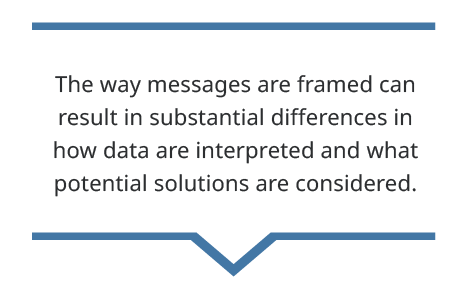Importance of reframing

In public health, health outcomes are traditionally examined by select demographic characteristics, including race and ethnicity, to highlight disparities in outcomes. It is less common for disparities to be framed as inequities and rarer yet to identify historical and current policy and systems factors that contribute to these inequities. Reframing how your program views health outcomes can help you understand how and why the existing disparities are unfair, unjust, and preventable. Reframing can encourage you to think about the underlying structural factors to effectively address racial inequities. The way messages are framed can result in substantial differences in how data are interpreted and what potential solutions are considered.
Racial equity reframing tool
The Racial Equity Reframing Tool (Figure 1.1) is one way to explicitly describe traditional approaches, and then challenge the underlying assumptions and expectations of those approaches. This exercise often exposes unspoken, pervasive assumptions that underlie how we think about our work. By surfacing these assumptions and making them explicit, your program can question whether they are helping to address inequities or if they might, in fact, be reinforcing inequities.
The Racial Equity Reframing Tool uses five questions, or framing elements, that can be discussed using qualitative data, needs assessment findings, and input from community partners.
This is an exercise you can do multiple times, with multiple audiences, over time and continue to learn and grow your analytic capacity for applying a racial equity reframe. At any point in your journey, you can return to this step to consciously question the assumptions that are informing your work.
Figure 1.1: Racial Equity Reframing Tool
| Framing Element | Traditional Approach | Racial Equity Approach |
|---|---|---|
| 1. What is the problem? | This is often the problem as defined long ago and reinforced by education and access campaigns over years of programming and funding cycles. | What is the inequity of interest? Are specific groups bearing a greater burden or affected differently? Who or what has defined the problem? Where is the injustice? |
2. What is the cause? What/who is responsible? | Individual behaviors/actions are often identified as the root cause of the problem. | What are the root causes (think about the social determinants of health (SDoH), policies, historical context, etc.)? Think about the individual level, interpersonal level, organizational level, community level, and public policy levels. |
| 3. What is the solution? | When the cause of the problem is deemed a result of individual action, the solutions developed are likely to be individual-level interventions. | How do you address the root causes identified above? What can be done about internal policies (e.g., program and agency policies)? What is the link between SDoH and larger policies (e.g., government, health system)? |
| 4. What action is needed? | Traditional approaches often center on individual-level education or clinical intervention and likely guide you to engage only the same partners, use the same language, and/or analyze the same data as you have previously. | What actions are needed to get to the solutions above? Are you engaging the right partners, including the community? What processes are needed for engaging those partners? |
| 5. What values are highlighted? | Traditional approaches often highlight personal responsibility, individual choice, etc. | The Racial Equity Approach often highlights equity, fairness, shared responsibility, etc. |
Source: Adapted from the Racial Justice Reframing Tool, Nashira Baril, MPH and Abigail Ortiz, MPH, MSW, 2016.
Racial equity reframing tool example
Figure 1.2 represents an example from a diabetes program of how a racial equity reframe was used to reimagine how they approach their prevention efforts.
Figure 1.2: Racial Equity Reframing Example – Diabetes1
| Framing Element | Traditional Approach | Racial Equity Approach |
|---|---|---|
| 1. What is the problem? | High rates of diabetes | Persistent racial inequities in diabetes rates for low-income Caribbean Latino seniors. They are healthy in the Islands, and they get sick when they come here. |
2. What is the cause?
What/who is responsible? | Poor nutrition, lack of exercise, overweight/obesity
Individuals | Food deserts, income inequity, and racial redlining in transit lead to social isolation and lack of community support; zoning for green space, etc. in communities of color; disinvestment in communities of color; residential segregation
Businesses, policy makers, multiple institutions and unfair systems |
| 3. What is the solution? | Improve nutrition, increase physical activity | Food security in all communities; economic investment in low-income communities and communities of color; accessible and affordable healthy foods in all communities (particularly communities of color) |
| 4. What action is needed? | Nutrition education classes, exercise classes | Food access policies that target root causes of inequities; economic policies that invest in communities of color; partnerships across sectors and with community residents |
| 5. What values are highlighted? | Individualism; personal responsibility; choice; individual freedom | Equity; justice; fairness; shared responsibility |
Reflection
As you apply your racial equity reframe, check in with your team about what you have learned from this exercise.
- What surprises you?
- What assumptions did you have that were challenged?
- How does this inform your future thinking and planning?
- Do you have established relationships with the communities you serve? How would their voice change the reframing exercise?
- How can you take your initial reframe and bring it to other collaborators?